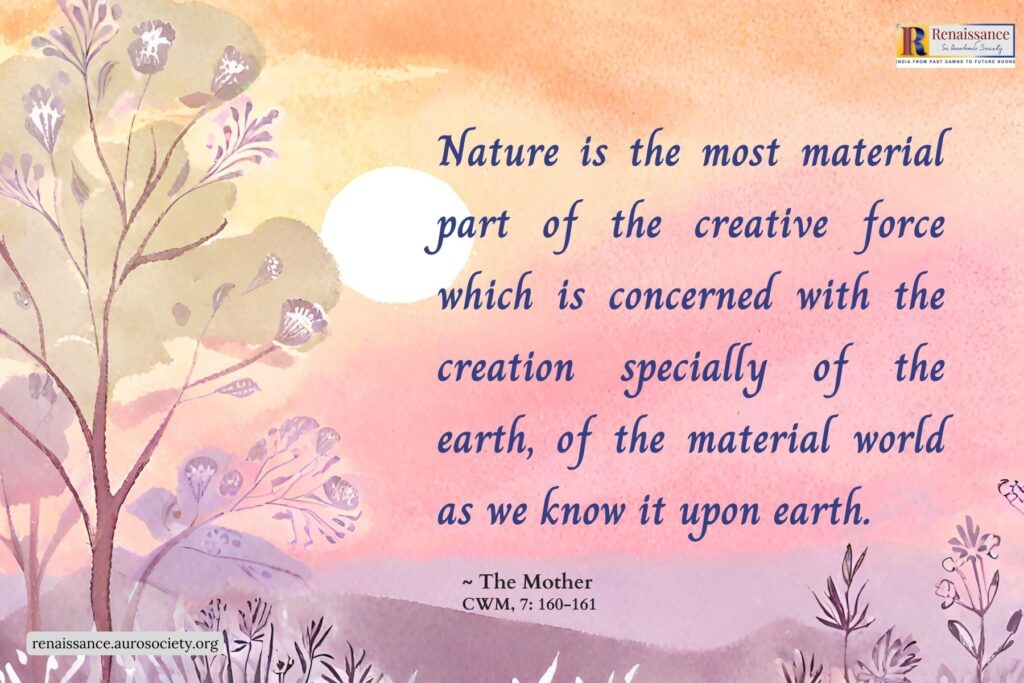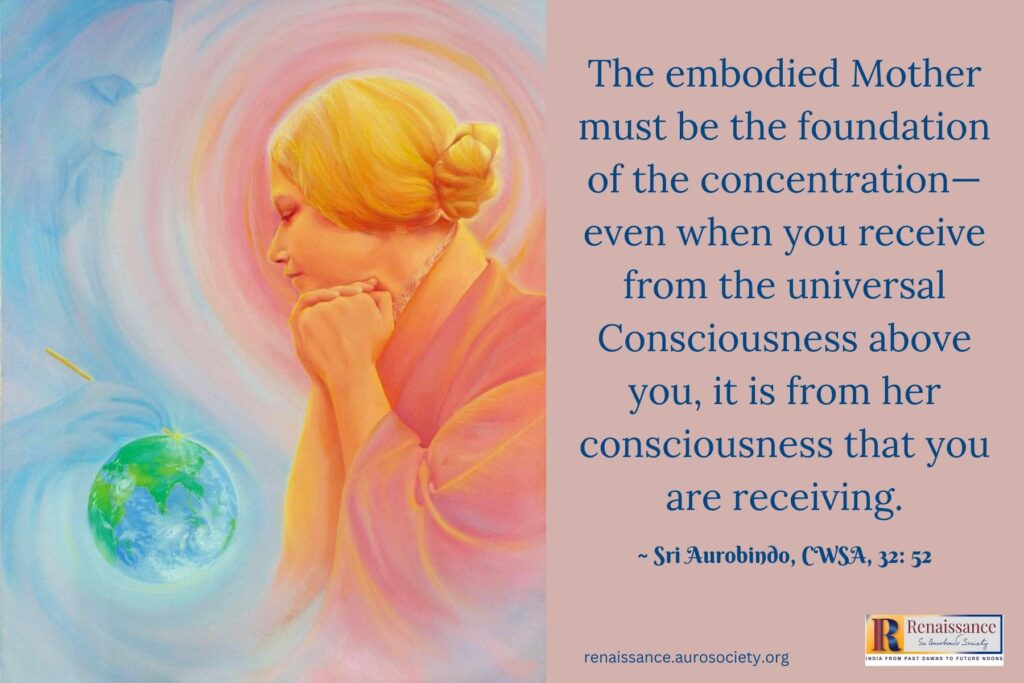Editor’s note: As part of our special offerings for the Mother’s birthday, our focus on the Mahakali aspect of the Mahashakti continues with this ‘Book of the Month’ feature.
Presented here is a reading of a contemporary work by Saiswaroopa Iyer (the author we interview for our Insightful Conversation series this month), titled ‘Abhaya: The Legend of Narakasura Vadha‘ (Bloomsbury) in the light of Sri Aurobindo. The reviewer writes that the story of Abhaya can be a means to take a mindful reader deeper into his or her own quest for Truth through the maze of what is fact and what is fiction, what is history and what is mythology, what is true and what is false.
Click HERE for a conversation with Saiswaroopa Iyer.

“I revere Krishna today as one of the first architects of a unified India. Yes, I believe he did exist in the obscure history of India…. Abhaya has been my window to explore and experience Krishna Vaasudeva.”
– Saiswaroopa Iyer
This is how Saiswaroopa Iyer introduces the second lead of her debut novel, Abhaya, in the Author’s Note. Krishna Vasudeva is second leading character because the first place is reserved for his love, his beloved Satyabhama, who takes the name and form of Abhaya in this marvellous and moving reimagination by Saiswaroopa Iyer.
Who is Abhaya?
The novel, Abhaya is set in the times of the Mahabharata. And as the subtitle suggests, it reimagines the story of the killing of Narakasura, an episode narrated richly and variedly in Bhagavatam, Vishnu Purana, Harivamsa, and also some legends and folklores of Assam region.
The protagonist of the novel, Abhaya Dharmaseni, is the princess of Anagha, a small fictional kingdom in the neighbourhood of Avanti in Bharatvarsha, the land of the Aryas. While reading the book and particularly as the story unfolds, one recognises that the term Arya is used in its absolutely correct sense as explained by Sri Aurobindo.
“. . . the Aryan peoples are those who had accepted a particular type of self-culture, of inward and outward practice, of ideality, of aspiration. . . In later times, the word Arya expressed a particular ethical and social ideal, an ideal of well-governed life, candour, courtesy, nobility, straight dealing, courage, gentleness, purity, humanity, compassion, protection of the weak, liberality, observance of social duty, eagerness for knowledge, respect for the wise and learned, the social accomplishments.”
– Sri Aurobindo, CWSA, 13: 441
Also see:
Humility, Nobility and the Aryan Character
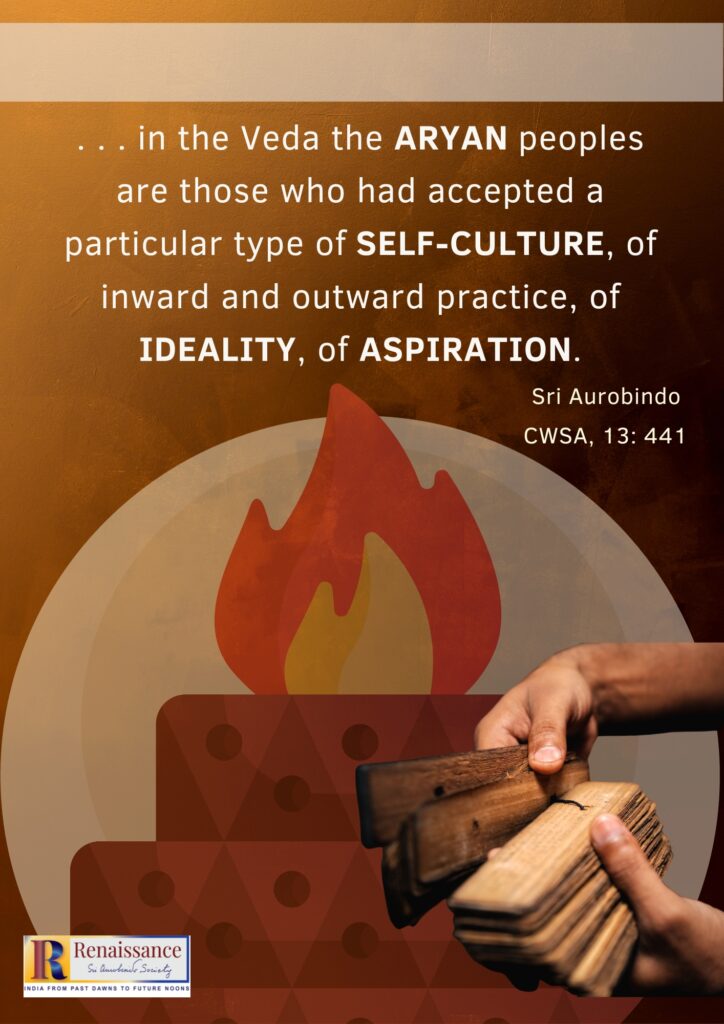
Abhaya is raised in this Aryan culture by her noble father Dharmasena, and she naturally grows up to be a woman conscious of living in and living for Dharma.
Her antagonist is Bhauma, who in the name of religion – religion of the Goddess nonetheless, – does all that can be done to control and possess people and their minds. His is a quest for brute and unlimited power using religion, or rather perversion of religion to poison minds, create division and chaos in society, take advantage of the vulnerable and unleash hedonism.
Battle between Dharma and Adharma
Abhaya’s plot situates itself firmly in the timeless tradition of Indian storytelling, one which the Indian mind never tires of, namely the story of battle between dharma and adharma. And yet it keeps its freshness and newness in two important ways.
One, there are no supernatural acts performed by some divine being. Even Krishna is as human as Abhaya or the author herself, who writes in her introductory note that Abhaya has been her “window to explore and experience Krishna Vaasudeva.”
Abhaya finds in Krishna not only a true companion, friend and the love of her life, but also one who has shown her the vision of a Bharatavarsha – the land where dharma must be the basis for a truly harmonious collective life of people. She is now fighting for a cause that is much bigger than her kingdom. She has found a purpose, and as Iyer says in her Author’s Note, this has made her become Krishna.
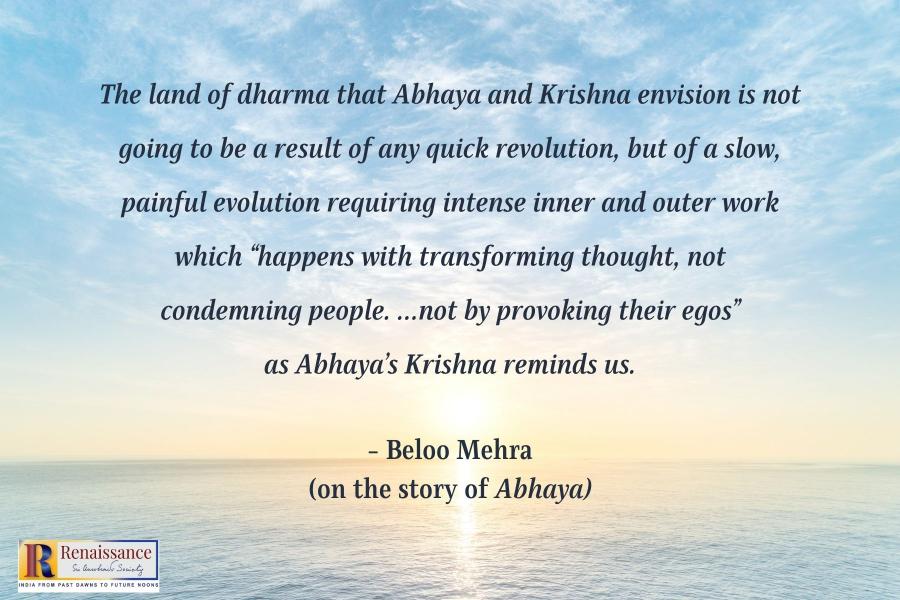
Check out more books featured in Book of the Month
Second, the deeper understanding of dharma at the core of this reimagined tale comes across clearly as “all that helps us to grow into the divine purity, largeness, light, freedom, power, strength, joy, love, good, unity, beauty.”
The adharma that Abhaya and Krishna fight against “presents a front of perversion and contradiction, of impurity, narrowness, bondage, darkness, weakness, vileness, discord and suffering and division, and the hideous and the crude, all that man has to leave behind in his progress” (Sri Aurobindo, CWSA, 19: 172). The author has given an outer form to this adharma in the portrayals of Bhauma and his perverted religion. This is the reactionary force which makes for evil, ignorance and darkness and which draws the humanity backward and downward.
This reminds me of an important distinction made by Sri Aurobindo between two aspects of religion – religion as spirituality and as religionism. Rejecting religionism or sectarianism in religion and ardently advocating spirituality he writes:
“It is true in a sense that religion should be the dominant thing in life, its light and law, but religion as it should be and is in its inner nature, its fundamental law of being, a seeking after God, the cult of spirituality, the opening of the deepest life of the soul to the indwelling Godhead, the eternal Omnipresence.
On the other hand, religion when it identifies itself only with a creed, a cult, a Church, a system of ceremonial forms, may well become a retarding force and there may therefore arise a necessity for the human spirit to reject its control over the varied activities of life.
~ CWSA, Vol. 25, p. 177
In this sense, the author intelligently manages to emphasise an important point that dharma is not same as religion.
This is important to understand because it is this wrong translation and false understanding of dharma as religion that has led to much of the socio-political-cultural conflicts that we see in present-day India.
If the Infinite, or seeking for the Infinite is the major chord of the Indian culture, the idea of the Dharma, says Sri Aurobindo, is only second to it. Dharma [1] essentially is the foundation of life, only next to the spirit, according to him. Abhaya and Krishna in this novel are fighting to preserve and strengthen this very foundation of life.
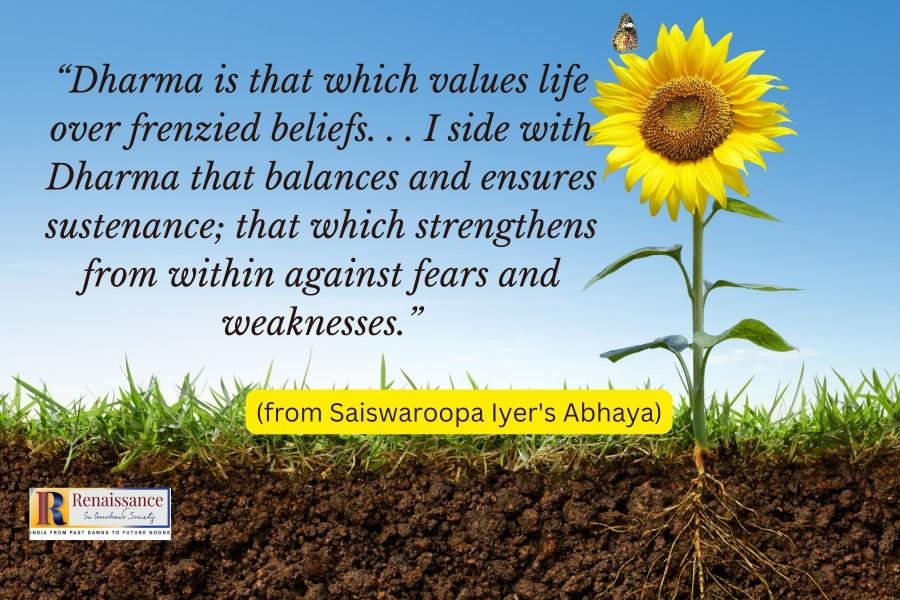
Abhaya, an Embodiment of the Shakti
The form of adharma as depicted by Abhaya’s author is where we find another key strength of this novel.
There is much that is dark and evil and ignorant and vile in Bhauma’s cult of goddess worship. And yet the reader still somehow knows and is made to realise it firmly, that all this is a falsehood, a perversion, a very dark perversion, of the deeper truth that Abhaya’s and Krishna’s Bharatavarsha holds dear and deeply values – the Truth of Shakti, the Supreme Creative Force, the primordial cosmic energy which represents the dynamic forces and moves through the entire universe.
This Shakti is in essence the divine feminine creative power; and Abhaya, the protagonist is placed in front of the reader as a true embodiment of this power in sharp contrast to the dark perversion that Bhauma is peddling.
Read: The Mahakali Aspect of the Divine Mother
This is not some post-modernist ‘shades of grey,’ or ‘there is good and bad in everything’ kind of nuance that the author is using here. It is, in fact, a deep spiritual truth which Saiswaroopa Iyer has masterfully expressed through her creative genius.
This truth is explained by Sri Aurobindo when he writes that evil and falsehood “are fruits of unconsciousness and wrong consciousness and, if true or whole consciousness is there replacing Ignorance, they have no longer any basis for their existence.” He adds — “. . . of good and evil it can be said that one exists by true consciousness, the other survives only by wrong consciousness” (CWSA, 22: 620-621) .
In Iyer’s novel, the true consciousness takes the form of Abhaya. She is fully supported and guided by Krishna and aided by other allies who are ready to not only persevere but also struggle and act forcefully and powerfully on the side of the dharma with all their might.
Evolution, not Revolution
The land of dharma that Abhaya and Krishna envision is not going to be a result of any quick revolution, but of a slow, painful evolution. This requires intense inner and outer work which “happens with transforming thought, not condemning people. . . not by provoking their egos,” as Abhaya’s Krishna reminds us.
Such work demands great clarity of perception and, as he adds, clarity of choice “to dwell on strengths while accepting weaknesses, to stay with faith while acknowledging fear, to side with reason above rigidity without abandoning those who are rigid. The result, the evolution we dream of, will come with time as a function of our choices.”
Such dharma warriors reflect the true Aryan spirit and live what Sri Aurobindo calls as “the combined ideal of the Brahmana and the Kshatriya.” (CWSA, 13: 441).
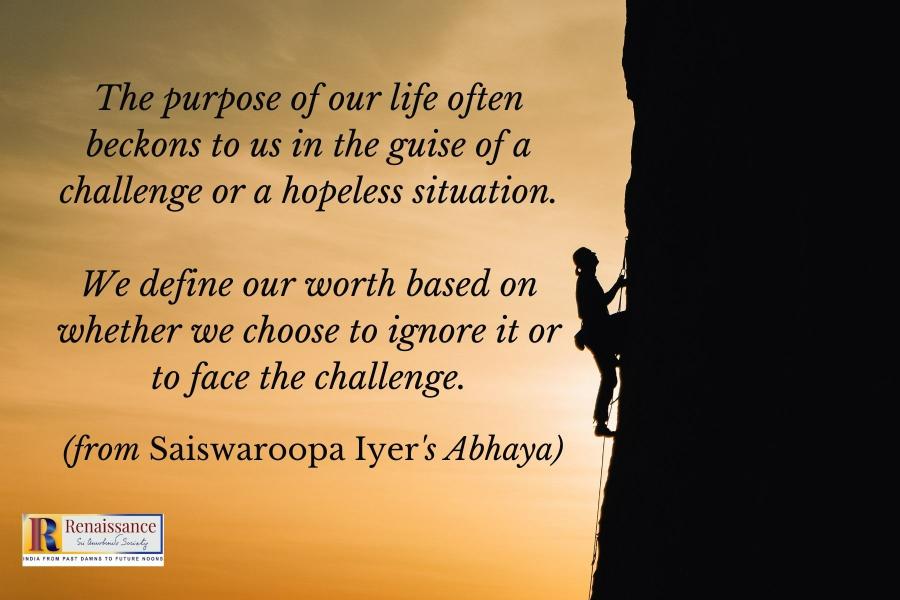
Some More Inspiration from Abhaya
The plot of the story is an inspiring one, especially when one sees its deep significance for our times. More and more Indians now recognise that the real work of nation-building must move on to deepening a psychological unity grounded in the truth of Indian civilisation and the soul-values it has upheld for millennia.
What makes Iyer’s narration even more delightful and contemplation-worthy are the wonderful pearls of wisdom blended seamlessly either through the dialogue between characters or the dialogue within a character. Some of these are also about the evolutionary nature of the true work of nation-building.
Here are a few such examples which I found especially insightful:
- “The purpose of our life often beckons to us in the guise of a challenge or a hopeless situation. We define our worth based on whether we choose to ignore it or to face the challenge.”
- “Bharatavarsha has reached that unfortunate state where every small proposition for change sends ripples of hostility up across the classes of people. The ones responsible for bringing about change– the Rishis– cannot do it themselves without the co-operation of the rulers. The rulers don’t or cannot enforce change if they see it as a threat to their power. The commoners, driven by fear of the unknown, are not open to experimenting with change. The few who rebel are put down in no time. . .?”
- “An evolution is inspired by the individual’s internal will to adapt and not by rebellion spurred by momentary dissent. . . Fear is what stops us from questioning and exploring new shores.”
- “Hypocrisy, lack of responsibility – these are big words. We only need to accept that everyone is driven by their needs. Once he sees the greater good as his own need and not a favour to the world, the world inevitably becomes a better place. Beliefs are not stagnant, Subhadra. They change. So do the people who rest their faith on those beliefs. Some are guided by their materialistic ends, some driven by the need to secure a better life for their children, some influenced by the sheer logic of the change that is proposed and yet others inspired by the strength of truth. People do welcome change. But then we need to cure their fear and instill faith. Once their fear is dispelled and faith restored, it is they who drive us towards the evolution and not the other way round.”
And a few more:
- “A true practitioner of any religion does not try to influence a juvenile mind.”
- “The constraints of tradition cannot limit those taking up the cause that seeks the welfare of the universe.”
- “Practising a religion is a personal sadhana. . . We don’t choose a religion because of stupid claims of superiority. We choose a certain religion not only because its tenets suit our temperament, but also because practising those tenets helps us to overcome our weaknesses. It is an endeavour to kill false pride and the sense of superiority. It is an endeavour to feel one with the universe.”
- “Man needs the grace of Shakti to transcend his limits.”
- “Truth is not bitter, . . . Truth is truth. For those who strive to work towards it, it is the light. For those who revel in predictions of doom, it is darkness. . . Truth does not carry the stench of hatred or anger.”
- “Dharma is that which values life over frenzied beliefs. . . I side with Dharma that balances and ensures sustenance; that which strengthens from within against fears and weaknesses.”
- “Learning from the world means that you become a better you and not change yourself into someone else.”
- “Faith is what keeps fear at bay. If fear is quelled, change is possible…”
- “Rigidity too is a function of fear. . . “
- “. . . doubt, once it is sown in one’s mind, becomes an overgrown banyan tree, leaving no opportunity for other thoughts to survive.”
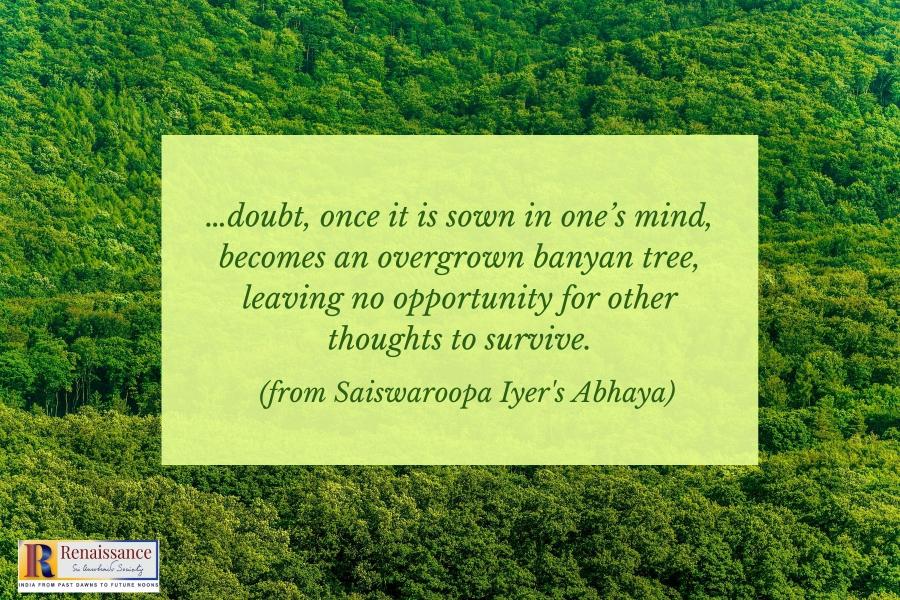
In Closing
Abhaya: The Legend of Narakasura Vadha is a must read for anyone interested in powerful and meaningful fiction that inspires and elevates. The story as well as the narration definitely take a mindful reader deeper into his or her own quest for Truth through the maze of what is fact and what is fiction, what is history and what is mythology, what is true and what is false.
There is a lot more in Abhaya’s plot and subplots which I have not addressed here. Let that be left for the reader to discover. The book is available both as paperback and kindle version.
Notes
1. “Dharma in the Indian conception is not merely the good, the right, morality and justice, ethics; it is the whole government of all the relations of man with other beings, with Nature, with God, considered from the point of view of a divine principle working itself out in forms and laws of action, forms of the inner and the outer life, orderings of relations of every kind in the world. Dharma is both that which we hold to and that which holds together our inner and outer activities. In its primary sense it means a fundamental law of our nature which secretly conditions all our activities, and in this sense each being, type, species, individual, group has its own dharma.
Secondly, there is the divine nature which has to develop and manifest in us, and in this sense dharma is the law of the inner workings by which that grows in our being. Thirdly, there is the law by which we govern our outgoing thought and action and our relations with each other so as to help best both our own growth and that of the human race towards the divine ideal.” (Sri Aurobindo, CWSA, 19: 171-172)
Also read:
A Review of Maria Wirth’s “Thank You India”

~ An earlier version of this review was published on the reviewer’s blog.
~ Design: Raamkumar


